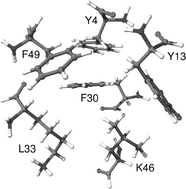The X3LYP extended density functional accurately describes H-bonding but fails completely for stacking
Abstract
The performance of the recently introduced X3LYP density functional which was claimed to significantly improve the accuracy for H-bonded and van der Waals complexes was tested for extended H-bonded and stacked complexes (nucleic acid base pairs and


 Please wait while we load your content...
Please wait while we load your content...